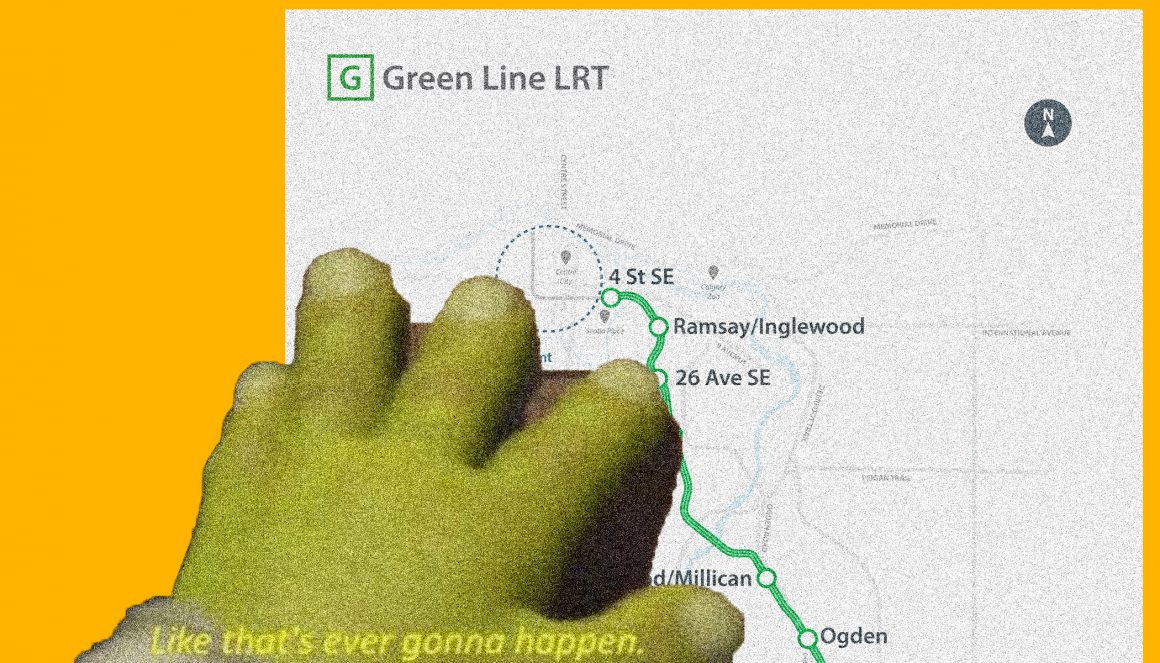
Stranded by delays: Why Calgary students need the Green Line
By Imran Ahmed, November 15 2024—
Over a decade and $1.3 billion later, Calgary’s Green Line LRT remains in limbo. Since its initial open houses in 2011 and the approval of a 46-kilometer alignment in 2017, the project has faced continuous delays, cost overruns and uncertainty. With yet another round of challenges, Calgarians, especially students and young professionals, are left wondering if the Green Line will ever be realized.
On Sept. 3, Alberta Transportation and Economic Corridors Minister Devin Dreeshen announced the cancellation of the province’s $1.53 billion funding commitment in a letter to Calgary Mayor Jyoti Gondek. The minister cited concerns over escalating costs and reduced ridership projections.
“As the provincial government, we have an obligation to ensure taxpayer dollars for infrastructure are allocated efficiently and in a manner that will benefit the largest amount of Albertans possible,” Dreeshen wrote.
With the provincial funding withdrawn, the city council voted to suspend the project. Although a complete assessment is pending, forecast expenditures are expected to exceed $850 million, bringing the total cost to over $2.1 billion. The city’s overdue transit investments will now be redirected to cover these expenses.
A few weeks later, an agreement between the province and city retained contracts for the southeastern section of the Green Line, from Fourth Street S.E. in Victoria Park to the planned Shepard station. While the impact of this decision on city costs is unclear, it preserved over 700 jobs and kept part of the project active for now.
The uncertainty around the Green Line affects all Calgarians, but its impact on post-secondary students is especially significant. According to the 2024 Students’ Union (SU) Annual Survey, 56 per cent of University of Calgary students primarily rely on public transit for their daily commute, while only 23 per cent drive. Without the Green Line, many students face substantial commuting challenges, particularly those in the city’s northeast and southeast.
In an interview with the Gauntlet, Mateusz Salmassi, the SU vice-president external and Calgary Student Alliance chair, emphasized the Green Line’s importance for students.
“Having a robust public transit network is crucial for post-secondary students to succeed,” Salmassi said, referencing the SU Annual Survey.
Calgary’s population boom has compounded the need for public transportation investment, driving up housing costs. The city’s population increased by 13.4 per cent over the past five years, and an October 2024 report by Urbanation and Rentals.ca showed average one-bedroom and two-bedroom rental prices at $1,780 and $2,224, respectively.
“With the housing crisis getting worse, more students are being pushed to the far corners of the city, where they are poorly served by transit. They are seeing up to two hours of commuting each way,” Salmassi explained. “The significance would be massive if students living in those areas [northeast and southeast] were also covered by an LRT, cutting their commute time.”
Salmassi also noted that businesses in anticipation of the Green Line expansion, as well as those already operating in its designated areas, have had to adjust their plans, affecting job prospects for students. A new LRT would connect tens of thousands of Calgarians, including students, to employment opportunities.
The documented benefits of a completed Green Line for Calgary, particularly for post-secondary students, include reduced commuting times, decreased traffic, and increased job accessibility. The Green Line is a crucial project for supporting Calgary’s rapid growth sustainably.
“An investment in the Green Line is an investment in Calgary’s economic future. Post-secondary students are already suffering under enormous affordability challenges and risking a major transit option that can get students where they need to go, whether that is their classes or jobs, would only make that worse” Salmassi said.
As chairman of the CSA, Salmassi emphasized the importance of forming strong networks with other advocacy organizations to facilitate quick reactions in situations like this. He added, “If students are well connected and not isolated, when there is a problem, there is a habit built on acting.
Updates on the Green Line can be found on the City of Calgary website.
This article is a part of our Opinions section and does not necessarily reflect the views of the Gauntlet editorial board.
